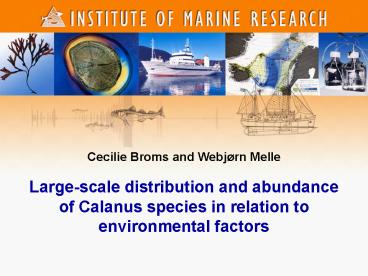PowerPointpresentasjon PowerPoint PPT Presentation
1 / 21
Title: PowerPointpresentasjon
1
Cecilie Broms and Webjørn Melle
Large-scale distribution and abundance of
Calanus species in relation to environmental
factors
2
Norwegian Coastal water
Atlantic water
Arctic water
3
- Geographical distribution of Calanus species
within the North-east Atlantic - and Polar oceans
- C. finmarchicus
- Northern boreal species
- Widely distributed in the North-Atlantic
- Centres of distribution the sub-polar
- gyre south of Greenland and the gyre of the
- southern Norwegian Sea
- C. glacialis
- Arctic shelf species
- Abundant in Arctic water masses in the
- Barents Sea.
- Found in low abundance in the deeper
- Greenland, Iceland and Norwegian Seas.
- C. hyperboreus
- Arctic species
4
- Geographical distribution of Calanus species
within the North-east Atlantic - and Polar oceans
- C. finmarchicus and C. hyperboreus are
- important prey for planktivorous pelagic
- fish as NSS herring, mackerel, capelin
- and blue whiting.
5
Aims
- Examine the distribution and abundance of C.
finmarchicus, - C. glacialis and C. hyperboreus in the
Norwegian Sea - Identify environmental factors implying the
distribution of Calanus species - Examine how the distribution of Calanus species
were affected by - these environmental factors.
6
Working hypotheses
- C. finmarchicus is abundant in Atlantic water.
- C. glacialis and C. hyperboreus are restricted
to cold Arctic water - Temperature is an important environmental factor
affecting and restricting - the distribution of Calanus species.
- The current system affects the distribution of
Calanus species.
7
Material Methods
- Six cruises from March August
- 102 stations
- - Salinity
- - Temperature
- - Chlorophyll a
- - Nitrate
- - Zooplankton (MOCNESS)
- Covering the growth season of Calanus
- in the Norwegian Sea
- Covering Norwegian Coastal water,
- Atlantic water and Arctic water
8
C. finmarchicus abundance and distribution in the
Norwegian Sea
- Highest abundance in Atlantic water
- Low abundance in Norwegian
- Coastal water and Arctic water
- Arctic front seems to be the
- north-western boarder
9
C. glacialis abundance and distribution in the
Norwegian Sea
- Low abundance in the Norwegian Sea
- Highest concentration in north-east,
- probably entering the Norwegian Sea
- from the Barents Sea.
10
C. hyperboreus abundance and distribution in the
Norwegian Sea
- Highest abundance in Arctic water
- Low abundance in Norwegian
- Coastal water and Atlantic water
- The Arctic front north-west in the
- Norwegian Sea restricts the
- distribution
11
Transect covering the Norwegian Coastal water,
Atlantic water and Arctic water in May
Transect across the Norwegian Sea between 69º
and 71º north Covering Norwegian Coastal
water, Atlantic water and Arctic water 12
stations high-lighted with red
12
Relative abundance of Calanus species from
Coastal, through Atlantic, to Arctic water
Coastal water
Atlantic water
Arctic water
13
Principal Component Analysis (PCA) biplot of
Calanus species
14
1. PCA axis Abundance of Calanus, mainly
governed by C. hyperboreus
- Norwegian Coastal water
- Low abundance of C. hyperboreus
- North of Lofoten all three Calanus
- species found
- Atlantic water
- Sporadic and low abundance of
- C. hyperboreus
- Arctic water
- Intermediate abundance of C.
- hyperboreus in Arctic water in south-west
- High abundance of C. hyperboreus in
- north-west
Jan Mayen
Iceland
Norway
15
2. PCA axis Calanus species distribution
- C. finmarchicus dominates Atlantic
- water in central Norwegian Sea
- C. glacialis and C. hyperboreus are
- found in Arctic water.
- C. hyperboreus belonging to fjord
- populations are observed along
- the Norwegian Coast
Jan Mayen
Iceland
Norway
16
Redundancy Analysis (RDA) triplot of Calanus
species versus environmental variables
Environmental variables
Responce variables
17
Responce of C. finmarchicus abundance versus
temperature using Generalized Additive Models
18
Response of C. glacialis and C. hyperboreus
abundance versus temperature using Generalized
Additive Models
C. glacialis
C. hyperboreus
19
Adaptations to low water temperatures and Arctic
environment
- Large body size
- Survive longer periods without feeding in areas
with longer unproductive seasons - and unpredictable feeding environment
- Reproduction
- Spawning well in advance of the phytoplankton
bloom with larvae surviving for a long - period without feeding
- Makes the new generation ready to take advantage
of the short and variable - spring phytoplankton bloom
- Life cycle
- Two- or multi-year life cycle
- Ability to survive as young copepodites if not
reaching near-adult stages before - overwintering.
20
Conclusions
- Calanus finmarchicus is abundant in Atlantic
water, while C. glacialis and - C. hyperboreus are restricted to Arctic water
in the Norwegian Sea. - C. glacialis is less abundant in the Norwegian
Sea - The Arctic front seems to be the north-western
boarder between the - distribution area of C. finmarchicus and C.
hyperboreus
21
Conclusions
- Temperature and the circulation system are
probably important - environmental factors affecting and
restricting the distribution - of Calanus species.
- Temperature may also be a proxy for potentially
mis-match between - the feeding nauplii and copepodite stages of
C. finmarchicus in Arctic water - and the phytoplankton bloom

